Picture new parents with babe in arms… picture a musician deep in the flow of a favorite piece… a child on a rocking horse… the crowd during the ballad at a summer concert… or sitting on the dock of a lake feeling the waves gently coming in.
What do these all have in common?
The swaying, the rocking, the shifting of body weight in a calming, co-ordinated way.
Don’t you feel calmer just thinking about it?
These moments of soothing movements are often instinctive, well-grooved habits.
Simple Self-Soothing Exercises You Can Do Anywhere
One of my favorite parts to teach in the Breath & Bliss Immersion is the section on rolling and floor-play. As a former professional Contemporary dancer, I have a very comfortable relationship with the floor as a place to explore my body’s association with gravity. We spent many, many hours learning to roll and tumble and explore moving in both subtle and grand ways within the floor space.
Exploring in this way with ease, while keeping the joints comfortable, takes a fine balance between just enough muscular tension and just enough yielding to the force of gravity.
Yes, this all begins with rocking and rolling… (cue the guitar solo!)
Here are a few rockin’ ideas to get you started!
First, lie on your back on a mat or even in bed, and sense all of the parts of yourself that are in contact with the supporting surface beneath you. Let your exhales act as permission to yield.
Now using as little effort as possible, roll your head from side to side. FEEL the unique architecture of your skull as you shift from right to left. Use less muscular effort, and then even less effort.
For a delicious version of this, just add the soft inflatable Coregeous® Ball under your head!
In Ardha Savasana (knees bent, feet on the floor), place the ball behind your head and neck where it feels best supported. (depending on the length your neck, there will likely be some overlap of the ball on the upper trapezius and/or the base of your skull.)
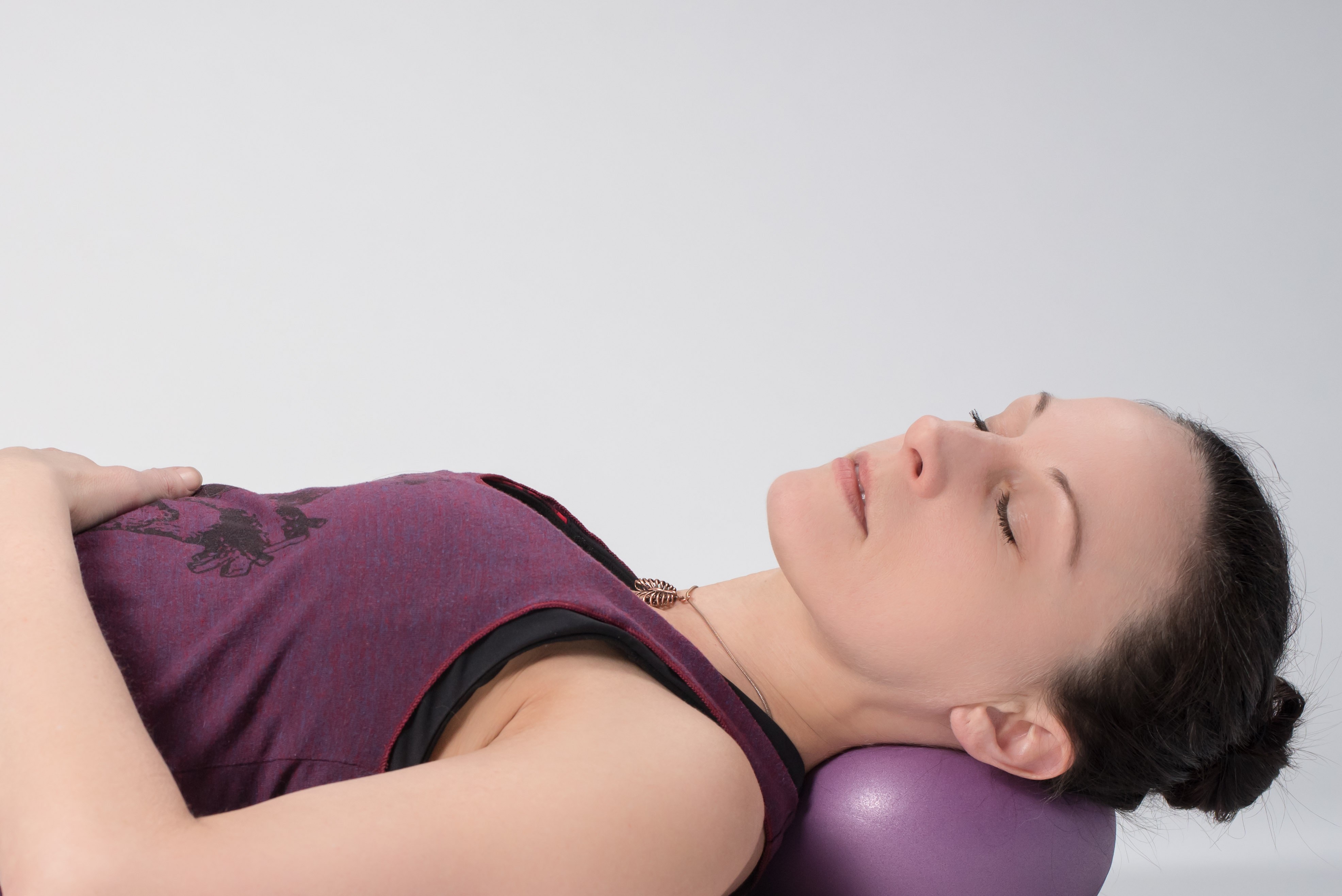
Now repeat the subtle head and neck motion: smaller, less effort. Bring back memories of lazy summer days in the pool on an inner tube, with nothing but your daydreams to occupy your mind.
For an extra soothing treat, wrap yourself in a cozy blanket and try the first version again. Maybe even hug a pillow or bolster.
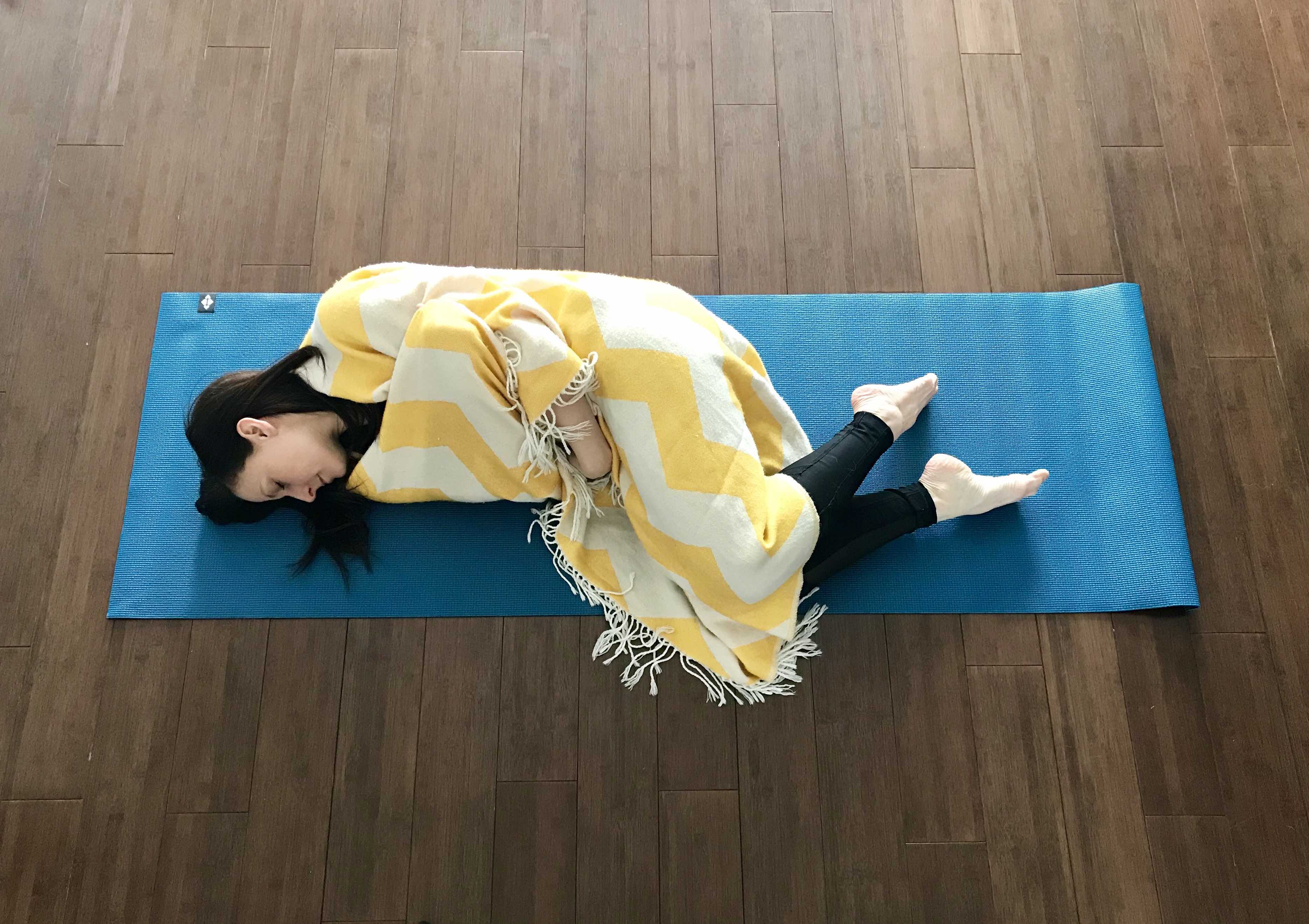
This time as your head rocks to the right, let the rest of your body spill over along with it: slowly, less effort, more like a massage for your tissues as they are gently compressed and rolled with the weight of your head, your shoulders, your hips.
Try an inhale on the way over to your side and an exhale to come back on to your back. Try going slower, and effort-ing less. (See a theme here?)
All of this is a great way to bring you into a deeper state of Parasympathetic dominance–to allow you to feel calm and grounded.
Bonus points if you are willing to hum while you rock, as humming helps to stimulate the Vagus Nerve.
How the Vagus Nerve Soothes Your Nervous System
The Vagus, Latin for “wanderer,” is just that: the longest of the 12 cranial nerves in your body. It starts at the brainstem and cascades its way to contact your heart and lungs, moves past your diaphragm into your visceral organs.
The Vagus is also involved in our Social Engagement System: It innervates the muscles of the face that allow us to convey and read each others’ emotions and reactions. The Vagus Nerve is also intimately linked to your HRV (Heart Rate Variability), your immune function and the adaptive responses of your Autonomic Nervous System.
In the words of Dr. Stephen Porges, in The Polyvagal Theory, its role is to support “Health, Growth & Restoration,” which in turn dampens the Sympathetic activity of “Fight, Flight, Mobilize.”
The Parasympathetic component of the Autonomic Nervous system (ANS) is often referred to as “Rest & Digest” or sometimes “Rest, Digest & Assimilate”. One of the many ways to nudge the nervous system into a parasympathetic state is to rock your body, rhythmically, in synchronization with your breath.
The first “simple” version of cervical rotations has a stimulating effect to the branches of the Vagus that run on either side of your neck, engaging the myelinated branches of the Vagus that innervate the facial muscles.
Intuitive Movements to Bring Peace and Calm
In the following video, I show a more dynamic version of improvisational, intuitive movements to soothe the nervous system. Have a look, then find a nice open space on your own floor and practice rolling instinctually around. Don’t worry about doing these self-soothing exercises right… just let your body rock and roll you for a while. Then sit up and notice how you feel.
Amplify Parasympathetic dominance, awaken the Social Engagement System and you are well on your way to feeling calmer, more grounded and in a place that can optimize health, growth, and restoration.
Join me at an upcoming Breath and Bliss Immersion if you’d like to delve deep into the science and practice of renewal and recovery…
Photo credits: All images and video of Lisa Hebert created by Lisa Hebert
Related Article: Two Minutes to Peace: Fun and Fast-Acting Relaxation Breathing Techniques for Stressful Times (Videos)
Learn more about our Therapy Balls and Programs
Interested in video and blog content targeted to your interests?
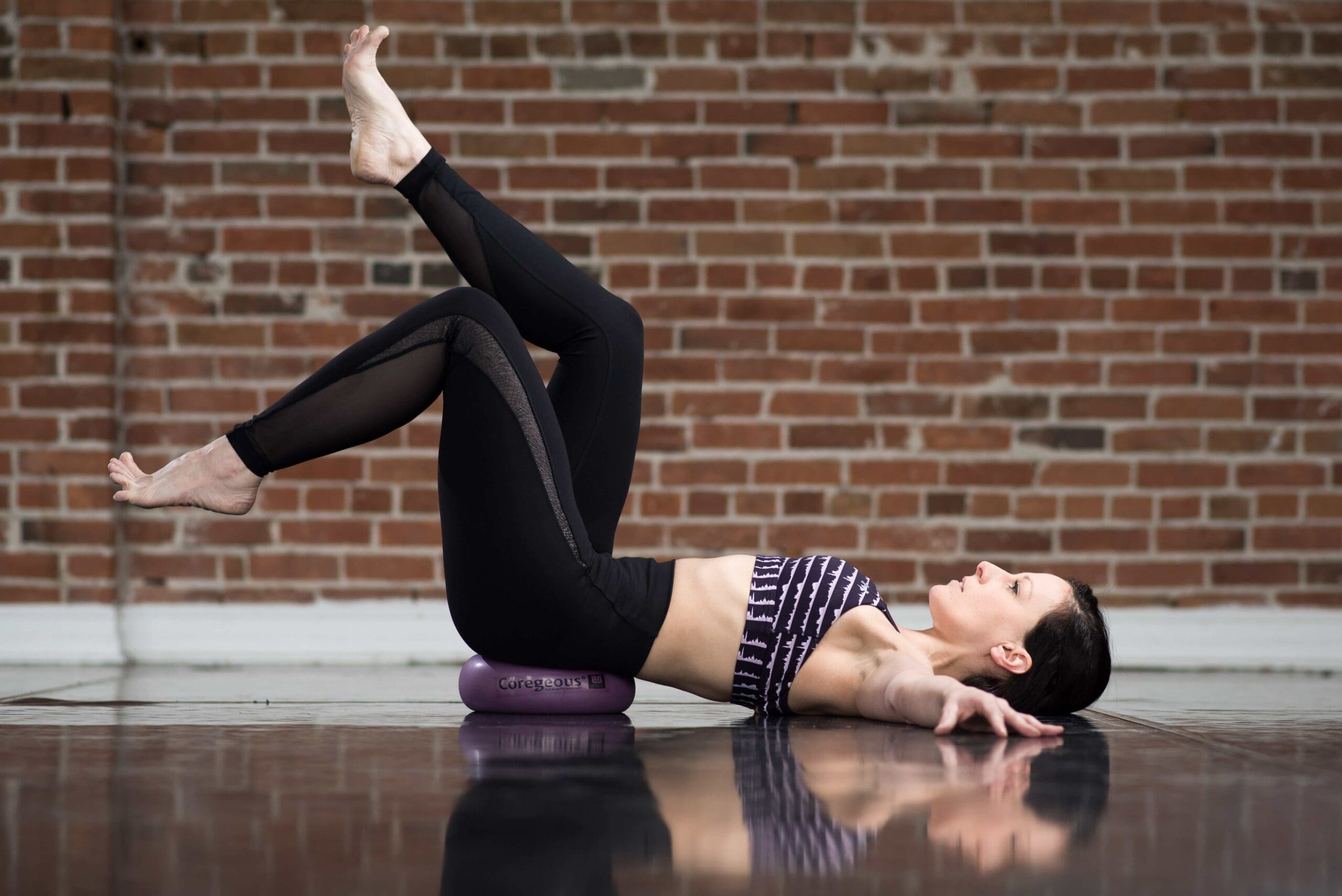
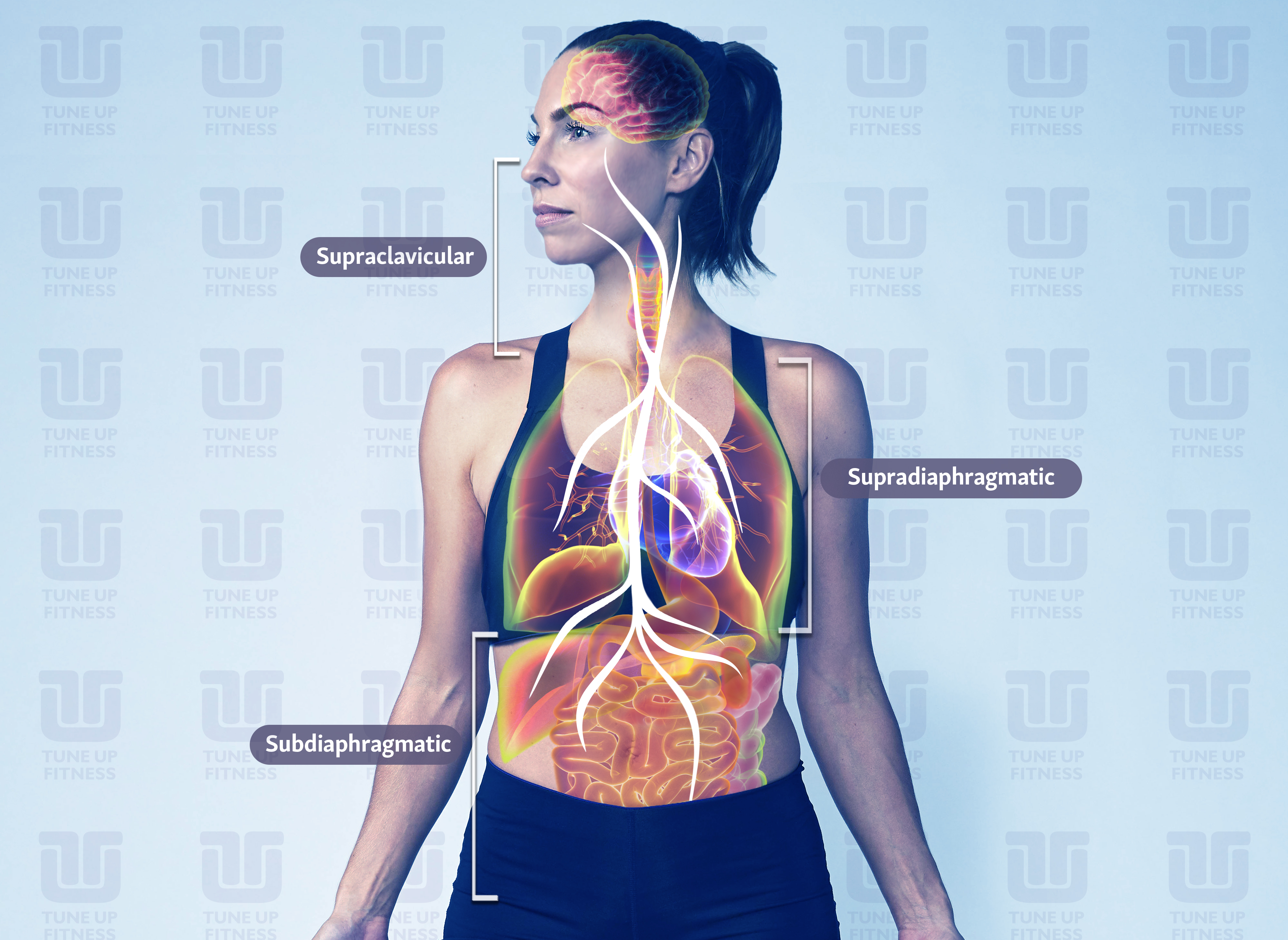



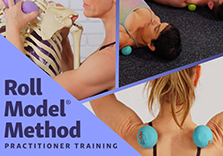






This blog kept getting better as I read on! I have been incorporating the coregeous ball behind the head and neck in practice, as a way to introduce peace and grounding, however I had never considered the vagus nerve stimulation! I am going to consider how to bring in longer time for exploration in this space in my restorative classes. Thanks Lisa!
Je vais tester ce soir avec un fond musical, rien que d’y penser mon système nerveux est tout pétillant….ça m’a l’air chouette la formation Breath and bliss
What I’m finding more and more for myself is how important it is to exercise the Parasympathetic state throughout my day. I love exploring movement on the floor and look forward to bringing back some modern dance improvisation with rocking and rolling the body. Thank you for this insight and inspiration.
This intuitively makes a lot of sense to me as I often rock before falling asleep. While the important of the Vagus nerve has been emphasized in many of the blog articles, it is not clear how rocking or other techniques (e.g., breathing practice) would calm this nerve.
I associate the vagus nerve with migraines, but I never thought of it as reading other’s emotions and reactions. And what a great way to become more grounded, through intuitive movement! Thank you.
This is such a fun way to calm the body and mind down. Can just imagine it is well suited for those who have a hard time doing regular down regulation.
The other day I was playing around rolling on the floor doing sexy dance moves, mimicking a past profession….. And my body felt so loose and free the next day… I’ve got to get my sexy back. Thanks for the reminder.
I am really interested in learning more techniques to activate the Parasympathetic Nervous System and to learn more about the Vagus Nerve. It was a very interesting article, thanks for the information. Also I want to try massage the back of my neck with the Coregeous Ball, I haven´t tried that massage before !
I could not believe that with the movements Lisa makes in the video you can activate the parasympathetic system by relaxing the vagus nerve. It reminded me of one of my children who, while watching television, moved from one side to the other on the floor or in the armchairs, lying down, sitting, spinning, giving dummies while still moving, and I told him to stop that he was going to dizziness, when it was something that was relaxing for him !! I would like to experience this option of relaxing through continuous movement or as Lisa calls it: The Rock and Roll and yes, it would be like dancing and dancing and releasing stress!
It is amazing how the littlest thing in daily interaction can affect our vagus nerve, causing tensions on our muscle. By self massage with the rolling balls, it helps to calm and soothe the nervous system and release our muscle tension.
The intuitive movement routine is something that I’ll add into my practice, it seems so nice to just move around in any way I feel like and letting my body take the best out of it. Thanks for sharing, I can’t wait to learn more about all this at Breath and Bliss!
Thank you for sharing these very grounded, self-soothing techniques that highlights the strong connection of mind, breath and body!
It seems like very good point to keep our mental health not simply reduce stress but. thinking about the relationship within myself with others.
relationship- corelationshp – self regulation- selfcare
Changing myself is the first ting we have to do. moving toward others not waiting until others come to me.
It is self creativity.
Some of the gentle and soothing nature of these poses allow for down-regulating the nervous system. This helps to bring balance to the mind, body and spirit.
I like this rocking and floor practice for soothing especially with the coregeous ball under my head. Thanks for the tips.
I am again reminded how the body and the mind cannot be separated. Great functional mobility excercises that better mirror how we move day to day
The floor-play aspect gives an interesting way to explore movement in a very relaxed way. We usually associate relaxation with passive stillness. This is a great alternative!
I am so grateful to have fallen upon this article. The poly vagal theory is so interesting. Many of the excercises are accessible to most. The vagus nerve is so interesting, very relaxing and calming.
Love this! I’m very interested in learning more about poly vagal theory, and in fact just started listening to the audio book Accessing the Healing Power of the Vagus Nerve on my way home from YTU level 1 training. Best part is is the most of these exercises are simple and accessible to most people. And I can’t help but think about how my cats love rolling around on the ground, especially in the sunlight (same for dogs!)
Just loved this article! Couldn’t wait to use it with my students. Great for restorative classes. The rocking and rolling combined with somatic movement are perfect right before savasana.
This reminds me of when I was a dancer, while at first it made me sad to think how much mobility I had lost, I turned it around and started rolling on the floor. I loved it and it soothed me to no end. Things are going to get better.
Thank you!
It’s very interesting to have the exercices first and the part of how and why we feel this way after. I will try for sur, it’s very well explain .
I love these intuitive movements.
They respect the amplitude of these main joints. Here’s an inspiring way to increase your joint mobility.
I remember this extra formation breath and Bliss. Thank you again Lisa. It’s a real pleasure. Xx
This is wonderful information which engages the want yo know more. Lisa you are a gift to this world. Thank you Teach for all that you offer and hold in space.
Blessings
Melaina Landriault
I love how this article started out as a feel-good tip and then quickly became a great anatomy lesson on the Vagus Nerve. It spoke to my love for self care and to the nerd in me. Excellent information and teaching tips.
I love the idea of soothing movement to relax and calm down the nervous system, I believe is the most easy way to restore the muscles in your body after excercice or an hour of practice. When in savasana i like to move very slowly my head from side to side, but the idea of using the coregeous under the head is great. I’ll try it.